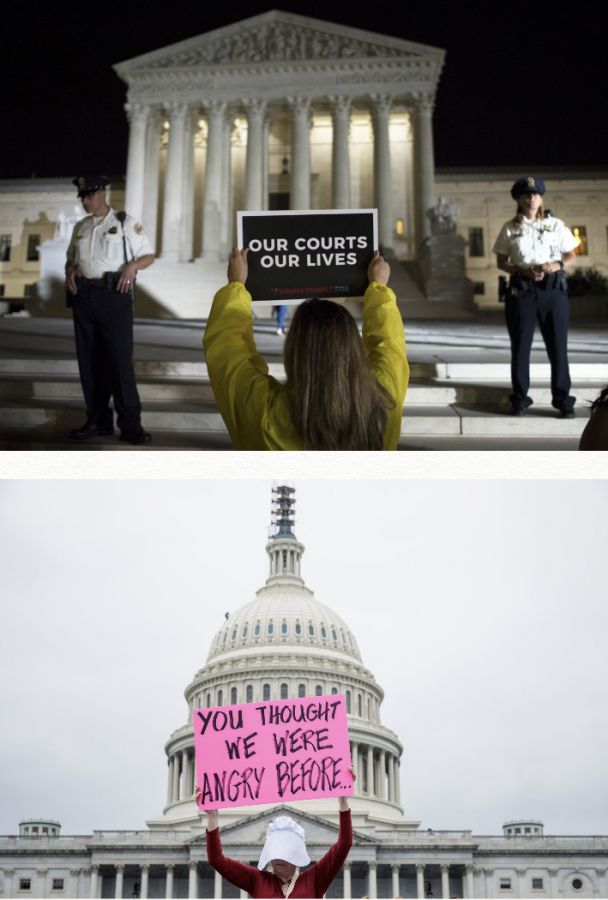Kavanaugh and Kava-nope
On July 9th, 2018, United States President Donald Trump nominated Judge Brett Kavanaugh to fill the vacant swing seat of former Supreme Court Justice Anthony Kennedy. Hours later, I was standing beside fellow protestors on the steps outside the Supreme Court (SCOTUS) in Washington, D.C. Standing in a circle that chilly night, bathed in cable news camera floodlights, we sang “This Little Light of Mine”, searching for a strand of hope in an otherwise somber atmosphere.
Eighty-three days later, in a 50-48 vote, the Senate confirmed Kavanaugh as the newest member of the Supreme Court. The road from July to October was a brutal, immoral partisan fight in open violation of norms of mutual tolerance and forbearance that exposed the corrupt underbelly of American politics. At 53 years of age, Justice Kavanaugh will be a part of a new conservative majority on the bench for decades to come.
A nomination to the Supreme Court ought to be the United States’ most demanding, cautious and difficult job interview. Justice Brett Kavanaugh failed this job interview unequivocally. As put by Senator Blumenthal of Connecticut in the Senate Judiciary Committee, the highly partisan efforts of Republican senators to railroad the nominee through the confirmation process to the bench were “a charade” and a “mockery of norms”.
Beyond his polarizing views and voting history on the Court of Appeals for the D.C. Circuit, there is also credible evidence against Kavanaugh relating to perjury before Senate committees. This evidence regards events such as the 2003 “Memogate” scandal, in which a Republic aide, Manuel Miranda, stole Democratic Party memorandums. In March of 2003, Miranda sent Kavanaugh an email with statements that were obviously copied and pasted from a Democratic Party document. A 2002 email from Miranda addressed to Kavanaugh is explicitly focused on stolen confidential Democratic Party emails and letters. However, during a 2004 hearing, Kavanaugh replied “No” to the question of whether he had received “any documents that appeared to you to have been drafted or prepared by Democratic staff members of the Senate Judiciary Committee.” At a 2006 hearing, Kavanaugh denied ever having received the stolen documents. However, the concrete evidence tying him to the spread and use of the “Memogate” documents highlights the perjury committed in his testimonies.
While a Supreme Court nominee is supposed to reflect the values of the incumbent president, it is clear that Trump’s nomination of Kavanaugh was also a decidedly political move. The United States is living in a moment where the executive branch is under investigation by a special counsel and the President has been named as a co-conspirator in court in at least two felonies. As expressed by Minnesota Senator Klobuchar during the Judiciary Committee hearings, “During this critical juncture in history the President has handpicked a nominee to the court with the most expansive view of presidential power possible. Of course, we are very pleased when a judge submits an article to the University of Minnesota Law Review, but the article you wrote that I am referring to raises many troubling questions. Should a sitting president never be questioned by a special counsel?”
In the article Klobuchar referred to, Kavanaugh wrote that he didn’t think a sitting president should be civilly sued or criminally prosecuted and investigated. At this moment in time, there is a realistic prospect that the president who nominated Kavanaugh will be subpoenaed by Robert Mueller’s special counsel investigation. If that happens, a case on the subpoena will reach the Supreme Court, and will effectively be decided by Kavanaugh’s tie-breaking (and undoubtedly Pro-Trump) vote on the bench.
As put by Klobuchar, “Our country needs a Supreme Court Justice who will better our legal system, a Justice who will serve as a check and balance on the other branches of government, who will stand up for the rule of law without consideration of politics or partisanship, who will uphold our constitution without fear or favor and who will work for the betterment of the great American experiment in democracy.” His appointment to the Court raises doubts about the extent to which those sitting on the Supreme Court are merely politicians in black robes.
Finally, there is the issue of the reckless and indecent episode that was his final testimony before the Senate regarding accusations of sexual assault put forth by Dr. Christine Blasey Ford. In a 2015 speech, Kavanaugh declared that “to be a good judge and a good umpire, it’s important to have the proper demeanor […] To keep our emotions in check. To be calm amidst the storm. On the bench, to put it in the vernacular, don’t be a jerk.” It is imperative that Supreme Court justices be seen as being above politics. The violence and raw partisanship Kavanaugh demonstrated before the Senate shows how he could not even live up to his own expectations of what a good judge must be. During his testimony, Kavanaugh constantly interrupted, insulted and yelled at Democratic senators, called accusations “a calculated and orchestrated political hit”, spun conspiracies of political vengeance campaigns against him, and refused to answer questions directly.
His behavior prompted retired Republican-appointed Justice Stevens to say that Kavanaugh’s performance was disqualifying. In an open letter, over 2,400 law professors in the United States signed a statement opposing Kavanaugh’s nomination given his behavior before the Senate.
A perfunctory FBI investigation into Dr. Ford’s credible testimony only highlighted the violently partisan nature of the confirmation process. Kavanaugh’s behavior described in her narrative is corroborated by allegations from multiple women. Sadly, not a single allegation has been properly investigated by federal law enforcement agencies under President Trump’s authority. Republican senators said they sympathized with Dr. Ford, however, their votes in favor of Kavanaugh’s confirmation show that her accusations were meaningless in their eyes.
Kavanaugh’s transition from Judge to Justice was a heavy blow to the image of the Supreme Court, to hopes of future bipartisanship, to norms of mutual tolerance and forbearance in American politics, to the #MeToo movement, and to survivors of sexual assault. The problems revolving around Kavanaugh were already around for decades before I stood outside the Supreme Court on a summer night in D.C. On October 6, the United States government showed the world it has barely changed since Anita Hill was disparaged by the Senate during Justice Thomas’ confirmation hearings.
Speaking before the Senate, Senator Schumer of New York said “the road that led us here has been bitter, angry and partisan — steeped in hypocrisy and hyperbole and resentment and outrage. When the history of the Senate is written, this chapter will be a flashing red warning light of what to avoid.”
Deborah Ramirez, one of Kavanaugh’s many accusers, issued a strong statement regarding Justice’s confirmation on the weekend of the final vote: “Thirty-five years ago, the other students in the room chose to laugh and look the other way as sexual violence was perpetrated on me by Brett Kavanaugh. As I watch many of the senators speak and vote on the floor of the Senate I feel like I’m right back at Yale where half the room is laughing and looking the other way. Only this time, instead of drunk college kids, it is U.S. senators who are deliberately ignoring his behavior. This is how victims are isolated and silenced.”
Sources: The Associated Press, The New York Times, The Los Angeles Times, The Washington Post, Slate, Crooked Media, Vox, University of Minnesota Law Review

Ever since he first “read” a book by himself (or at least phonetically memorized the contents after having it read aloud repeatedly), Alexandre has...

Title: Kecy Lu
Medium: sunshine, paint, Netflix, procrastination, and love on canvas.
Description: In this piece, the central figure, Kecy Lu, is...









